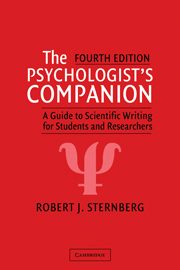Book contents
- Frontmatter
- Contents
- Acknowledgments
- Introduction
- 1 Eight Common Misconceptions about Psychology Papers
- 2 Steps in Writing the Library Research Paper
- 3 Steps in Writing the Experimental Research Paper
- 4 Rules for Writing the Psychology Paper
- 5 Using the Internet to Aid the Research Process
- 6 Commonly Misused Words
- 7 American Psychological Association Guidelines for Psychology Papers
- 8 Guidelines for Data Presentation
- 9 References for the Psychology Paper
- 10 Standards for Evaluating the Psychology Paper
- 11 Submitting a Paper to a Journal
- 12 How to Win Acceptances from Psychology Journals: Twenty-Nine Tips for Better Writing
- 13 Writing a Grant or Contract Proposal
- 14 How to Find a Book Publisher
- 15 Writing a Lecture
- 16 Article Writing 101
- References
- Appendix A Sample Psychology Paper
- Appendix B Writing for British and European Journals
- Index
4 - Rules for Writing the Psychology Paper
Published online by Cambridge University Press: 05 June 2012
- Frontmatter
- Contents
- Acknowledgments
- Introduction
- 1 Eight Common Misconceptions about Psychology Papers
- 2 Steps in Writing the Library Research Paper
- 3 Steps in Writing the Experimental Research Paper
- 4 Rules for Writing the Psychology Paper
- 5 Using the Internet to Aid the Research Process
- 6 Commonly Misused Words
- 7 American Psychological Association Guidelines for Psychology Papers
- 8 Guidelines for Data Presentation
- 9 References for the Psychology Paper
- 10 Standards for Evaluating the Psychology Paper
- 11 Submitting a Paper to a Journal
- 12 How to Win Acceptances from Psychology Journals: Twenty-Nine Tips for Better Writing
- 13 Writing a Grant or Contract Proposal
- 14 How to Find a Book Publisher
- 15 Writing a Lecture
- 16 Article Writing 101
- References
- Appendix A Sample Psychology Paper
- Appendix B Writing for British and European Journals
- Index
Summary
Rule 1. Your meeting should interest, inform, and persuade your reader. Psychological writing should not be dull or stuffy. You must interest your reader in your paper; otherwise, the reader will find something else to do. Even teachers reading course papers will often read boring papers more quickly and less carefully than they will read interesting papers. Although you can lose your reader at any time, the major decision points for the reader are the title, abstract, and introduction.
The optimal title is one that concisely informs the reader of what the article is about. Such a title will minimize the number of people who start the article only to find that the topic doesn't interest them, and maximize the number of people who start the article because the topic does interest them. The abstract should summarize the article and at the same time convey to the reader why the topic, hypotheses, and results are of theoretical or practical interest. The introduction should further motivate the reader by pointing out why the research is a necessary next step in putting together the pieces of an as yet unsolved puzzle. The reader should finish the introduction believing that you have (a) put together one or more pieces of the puzzle, and (b) pointed the way for further pieces to be put together.
- Type
- Chapter
- Information
- The Psychologist's CompanionA Guide to Scientific Writing for Students and Researchers, pp. 65 - 76Publisher: Cambridge University PressPrint publication year: 2003



